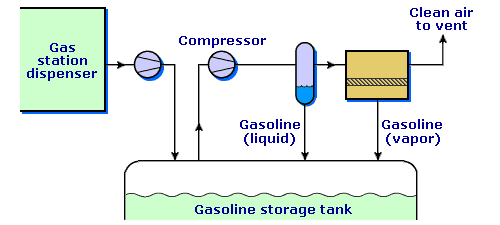Gasoline stations rely on vacuum-assisted dispensing systems to minimize the release of hydrocarbon vapors to the atmosphere.
Gasoline stations rely on vacuum-assisted dispensing systems to minimize the release of hydrocarbon vapors to the atmosphere. These systems use a small pump to draw air and vapors from the gasoline dispensing nozzle. For every liter of gasoline dispensed from the pump, as much as 2 liters of air and gasoline vapor are returned to the storage tank. Build-up of air in the tank leads to atmospheric releases.
MTR has developed a membrane vapor recovery system for the fuel storage tanks of retail gasoline stations. The Vapor Recovery system, fitted with MTR’s membranes, recovers gasoline vapors and returns them to the storage tank. Hydrocarbon emissions are reduced by 95% to 99%, significantly reducing the carbon footprint of the gas station.

Air from the gas station dispenser is collected and sent to the gasoline storage tank. When the pressure in the tank reaches a preset value, a pressure switch activates a small compressor that draws off excess vapor-laden air. A portion of the hydrocarbon vapors condense and is returned to the tank as a liquid. The remaining hydrocarbons permeate the membrane and are returned to the tank as concentrated vapor. Air, stripped of 95% to 99% of the hydrocarbons, is vented. In addition to eliminating hydrocarbon emissions, the unit pays for itself with the value of the recovered gasoline.